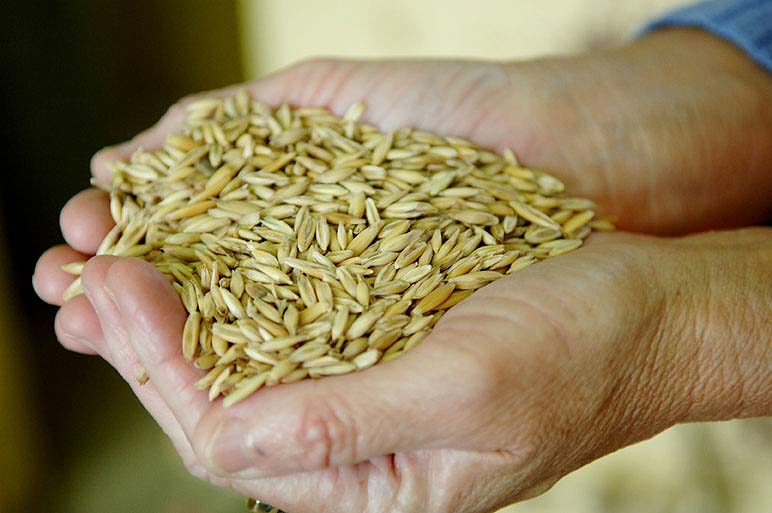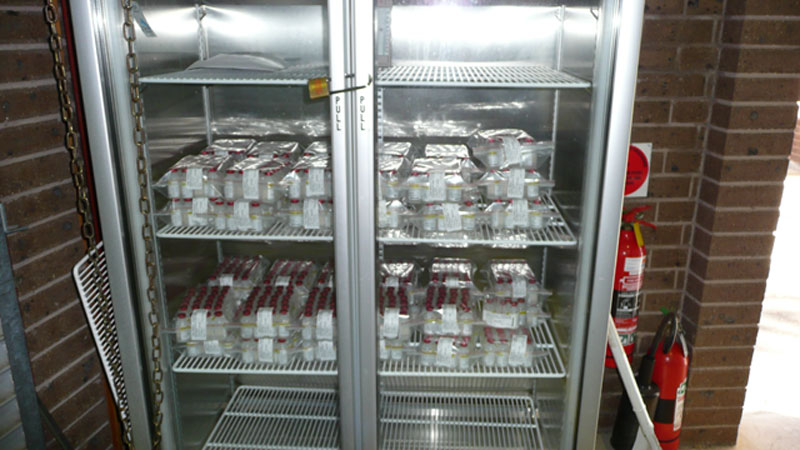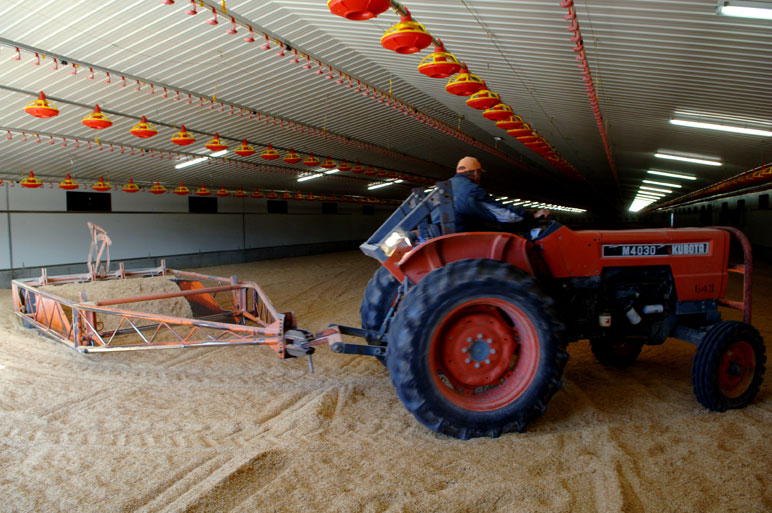Supply Industries
Supply Industries
Supply industries refer to a number of industries that supply goods and services to the poultry industry. Most of these also supply goods and services to other industries, especially to the livestock industries.
Organisations include those supplying the following:
Feed
The major input that the farmer makes to the production of poultry products is feed. It usually constitutes around 70 to 80% of the total ongoing production cost.
Breeding stock
Poultry breeding programs use the principles of genetics to select high performing birds. It is very expensive to keep a large population of breeders and only those who are prepared to take on such a cost can succeed in the commercial breeding industry.

Wheat grains (Source: Aust. Chicken Meat Fed.)
Feed ingredients
In addition to the main feed ingredients, such as grains (wheat, maize, sorghum, barley) and protein sources (meat meal, soybean meal, canola meal), feed must also contain vitamins and minerals as well as suitable medications when necessary (including in-feed antibiotics). Contrary to popular belief, hormones are not used in poultry feeds. A mix of minor ingredients (vitamins and minerals), called a premix are provided by specialist companies to be added to feed at mixing. Some essential amino acids are also commercially available to be included in poultry diets when necessary in order to balance the diet.
Egg packaging
Farmers have an opportunity to create a brand identity using distinct egg packaging. Every farmer has its own unique process for creating quality eggs and egg products. Egg consumers are keen to “get close to the farm” and when they understand how to appreciate the difference between farm products, they identify with the farm’s brand and buy more egg products from the farm. Companies like MyPak Packaging work with farmers to create this brand story.
Equipment
Some of the equipment used in the industry is very sophisticated. Electronic climate controls, special feeders, drinkers, foggers (for cooling chickens with a fine spray into the air, and also increasing the shed humidity), space heaters, egg incubators, litter mixing machines etc. are all supplied by specialist companies.
Vaccines
Many poultry diseases can be prevented by using vaccines to stimulate immunity. Most of these are live virus vaccines and special care is necessary to ensure they are alive and effective when used. When using and handling vaccines, always read and follow the instructions carefully. The importation of some vaccines is allowed, including some inactivated vaccines (e.g. Newcastle Disease, Egg Drop Syndrome) and a specialised list of live vaccine seeds (e.g. Marek’s Disease strains and Chicken Anemia Virus). Importation of these vaccines is under strict Australian Quarantine and Inspection Service (AQIS) controlled conditions.

Each vial of vaccine treats 1000 birds via eye drop
Medicines
When disease cannot be kept out of birds by isolation, hygiene and other preventive measures, it may be necessary to administer medicines to birds. A number of chemicals and antibiotics are used to treat and prevent some diseases. Antibiotics are added to feeds to help control diseases such as coccidiosis and necrotic enteritis. These diseases can cause considerable suffering and death in chickens raised on the ground. The antibiotics used must be approved and meet certain criteria. These criteria specify that the antibiotics must not leave residues in the meat, are only active against a limited number of organisms and are not related or similar to antibiotics which are used for human health. Most of the medicines used routinely are marketed in Australia by offices of multinational companies, which usually provide very reliable technical advice. Only medicines fully registered by the Australian Pesticides and Veterinary Medicines Authority for use in food-producing animals are allowed to be used in poultry in Australia.
Building and building materials
Poultry houses are usually made from steel or timber with steel cladding (usually corrugated colorbond and galvanized iron). Insulation materials are usually placed inside the roof and walls to assist in the control of temperature in the shed. Many modern evaporatively cooled tunnel ventilated sheds are completely enclosed so that temperature and light are controlled at all times. These are called controlled environment sheds, while older sheds are sometimes called conventional sheds. Older sheds often have wire netting sides with adjustable blinds made of plastic or shutters made of wood or metal to control ventilation. Fans are used in both types of shed to move hot humid air away from the birds to keep them comfortable and productive. Automatic controls are often used to adjust the ventilation and temperature.

Litter is usually comprised of cellulose based products
Litter materials
Some companies specialise in supplying materials to cover the floor of chicken sheds. Chickens kept on the floor, such as meat chickens and breeders, leave their faeces where they stand. The faeces contain a lot of water which can allow bacteria and flies to multiply.
To keep the faeces dry, the shed floor is covered with a material known as litter, which soaks up the moisture and allows it to evaporate. Litter also cushions birds from bruising and provides a comfortable base on which the birds can rest. The most suitable litter materials which are cheap and available are wood shavings, rice hulls, sawdust, straw and shredded paper. Wood shavings are more popular as litter material among all others, mostly because they have a high water holding capacity compared to the other materials used.
Veterinary services
One of the main factors capable of slowing down egg production or growth of chickens is disease. Correct diagnosis of disease is essential so that the proper treatment and prevention can be applied. Veterinarians with special experience in poultry disease are employed by poultry breeding companies and government departments to help fight diseases.
Credit (finance)
Banks are important in the industry as new farmers need money to get set up. The bank will usually have access to financial figures typical of the industry and can advise on the degree of risk involved in financial plans. It pays to shop around to find a bank which is familiar with your section of the industry.
Research and development
Australia’s rural industries have recognised the need for scientific and marketing research and development. To help Australia’s rural industries keep up with competitors in domestic and export markets, the Australian government has established a number of research and development councils. These councils are funded jointly by the industry and the government. The council has members from the industry with technical and commercial skills, as well as representatives of the government.
In the Australian poultry industry, there are three such councils: Agrifutures Australia formerly Rural Industries Research & Development Corporation (RIRDC), Australian Eggs Limited and the Australian Chicken Meat Federation (ACMF) which do not allocate funds. Research funds are allocated to individuals and institutions which make applications for projects nominated by the Councils or proposed by themselves as being important to the industry. Some state government departments and some industry organisations also have their own research activities.
Technical advice
In the layer industry, technical advice is usually available from the company supplying various materials used by the farmer. The advice needed for making decisions about bird care has traditionally been supplied by government departments of Agriculture or Primary Industry. In most states, these services are being reduced and it is expected that new farmers will need to employ a specialist consultant to get help. In the meat chicken industry, advice often comes from servicemen from the processing company.

